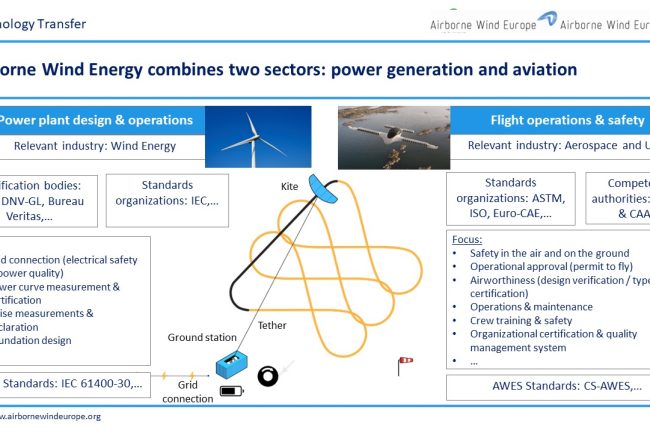Safety and Regulation
Coordinator
- Airborne Wind Europe (Kristian Petrick) kristian.petrick@airbornewindeurope.org
- CT Engineering (Agustín Arjonilla) agustin.arjonilla@ctingenieros.es
Topics and objectives
Question to be answered: How to deploy AWE safely in a technologically feasible and affordable way?
The Task will review existing siting, grid connection procedures, and permitting regulations in selected countries and develop guidelines for their adaption of AWE technology where necessary or appropriate for a smooth AWE deployment in Europe and worldwide. We will also elaborate on regulatory guidelines on how AWE should be treated regarding ground safety, and airspace integration (e.g. lighting & marking interference with air traffic). To that end, we will seek collaboration with the European Union Aviation Safety Agency (EASA) and the Federal Aviation Authority of the US (FAA), national, and regional aviation and permitting authorities, and other experts in the field (e.g. operators of unmanned aerial systems (UAS)).
With respect to different AWE operational approaches (offshore .vs. onshore; soft kite .vs. hard kite) we will elaborate on adequate safety guidelines, keeping in mind technological feasibility and affordability. We aim to trigger and where possible contribute to the development of international standards and guidelines for AWE (e.g. within the IEC-61400 for wind generators and aviation-related standards).
Concept of operations (CONOPS) guidelines for different AWE concepts
Power generation systems regulation on-ground safety (on the ground):
- How does AWE change existing regulations?
- Electrical system safety: How to deal with all ground station and grid connection-related components and related safety expected.
Aviation regulation:
- How does AWE fit into the current and future aviation regulations including ground safety of 3rd parties and airspace integration?
- Which laws and regulations apply (e.g. European Commission Implementing Regulation (EU) 2019/947 of 24 May 2019; FAA regulation; other national regulations) and how do they need to be adjusted to accommodate for AWE?
- How to apply Specific Operations Risk Assessments (SORA) assessments comparable to AWE concepts (e.g. Benchmark) required health monitoring and recovery systems to ensure the safety of 3rd parties.
- Airspace integration: How can AWE become a player in the shared concept?
Health, safety, and environment (HSE): Practical aspects of protecting the environment, maintaining health and safety at the occupation
Operations: How can design concepts and approaches, and standardization be benchmarked for different AWE operation approaches including aviation, ground operation; HSE)?
This WP will work closely with aviation authorities (EASA, FAA, CAAs, …) and other technical standardization entities (FGW, IEC, …).

White Paper of Safe Operation and Aerospace Integration of Airborne Wind Energy Industry
Deliverables
- D3.1 Whitepaper on AWES safety
- D3.2 Concept of operations (CONOPS) and guidelines on risk assessments (e.g. SORA)
- D3.3 Airspace integration concept; D3.4 Benchmarking concepts for safe automatic operation
Progress and Achievements
Status November 2022 [Annual Report]:
In WP3 a White Paper on AWE Airspace Integration was developed in collaboration with TwingTec in a project co-funded by Swiss FOCA. It provides a general framework for AWE systems that have to deal on the one hand with energy system standards (like IEC-61400 for wind generators) and on the other hand with standards and regulation related to unmanned aircraft systems (like EU-2019/947.
